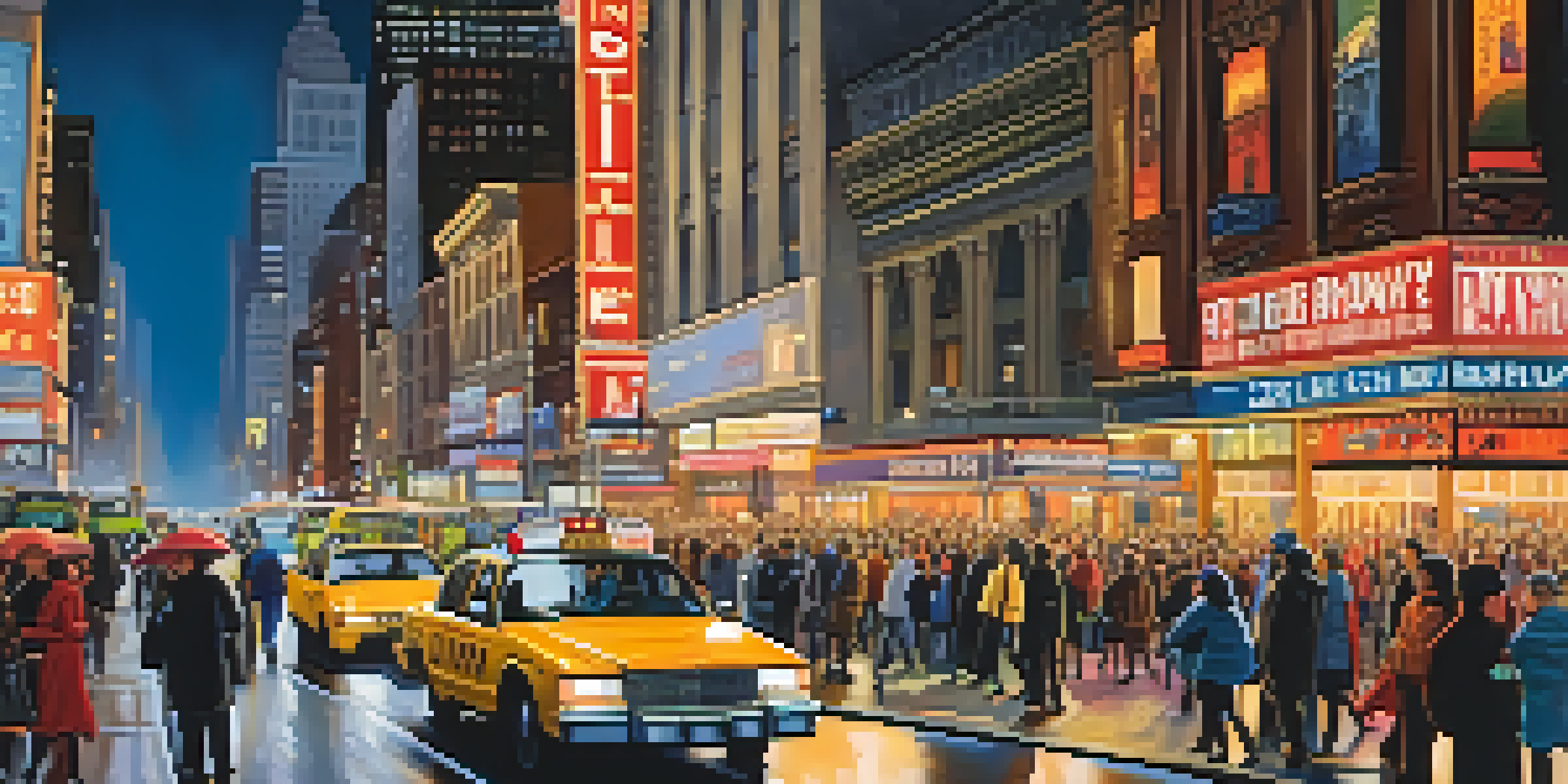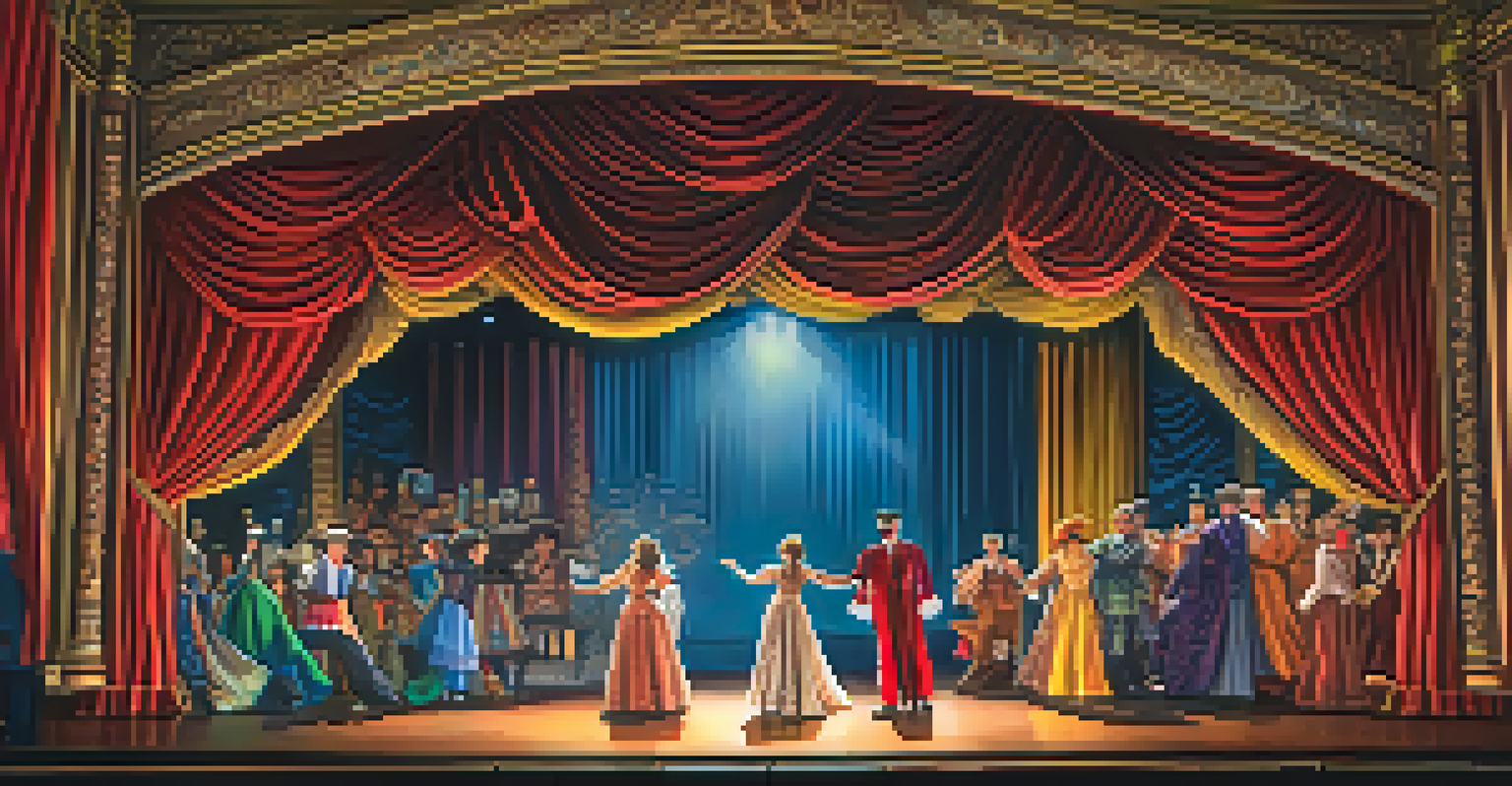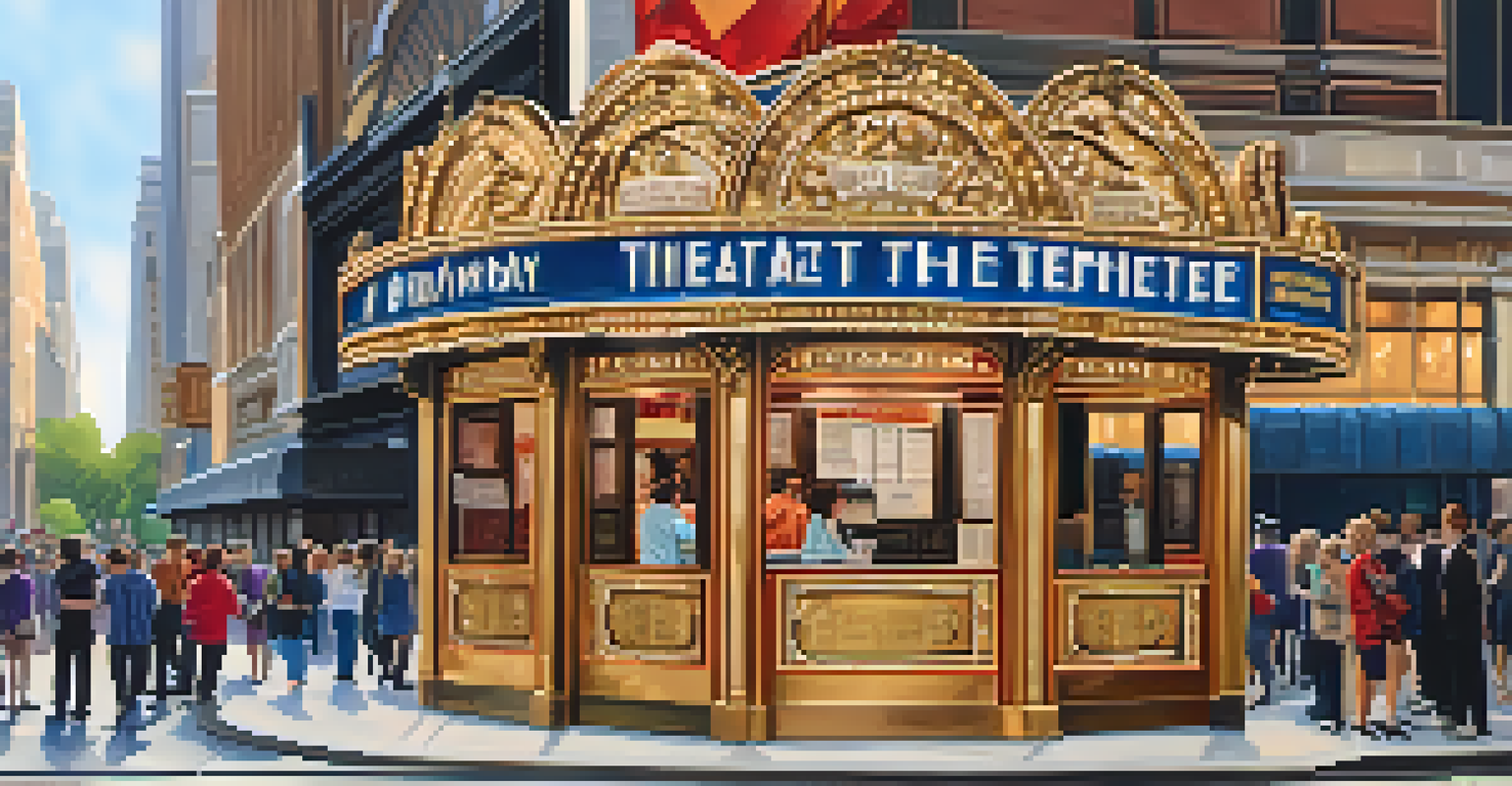The Financial Influence of Broadway on NYC's Creative Economy

Broadway's Role in NYC's Economic Landscape
Broadway is often seen as the beating heart of New York City's arts scene, but its influence extends far beyond the stage. Every year, millions flock to theaters, contributing significantly to the city’s economy through ticket sales and tourism. This influx of visitors also benefits local businesses, from restaurants to hotels, creating a ripple effect that enhances the overall economic landscape.
The theater is a world of possibilities, enabling us to see the world through different eyes.
The financial impact of Broadway is staggering, with estimates indicating that the theater district generates billions of dollars annually. This revenue doesn’t merely line the pockets of producers and performers; it supports a vast network of individuals, including stagehands, costume designers, and marketing professionals. Each production is a mini-economy, showcasing the interconnectedness of the creative sector.
Moreover, Broadway helps to solidify New York City’s reputation as a cultural hub, attracting artists and creatives from around the globe. This influx of talent not only enriches the local arts scene but also fosters innovation and collaboration, further enhancing the city’s creative economy.
Job Creation and Employment Opportunities
The Broadway industry is a significant source of employment in New York City, providing jobs to thousands of individuals across various disciplines. From actors to stage managers, the demand for skilled professionals creates a robust job market that supports the livelihoods of many. These roles often lead to additional opportunities within the broader creative sector, including film, television, and digital media.

In addition to direct employment, the indirect job creation associated with Broadway is noteworthy. Local vendors, catering services, and even transportation companies benefit from the bustling theater scene, resulting in a thriving ecosystem of support services. This interconnected web of employment highlights how a single industry can uplift an entire community.
Broadway Boosts NYC's Economy
Broadway significantly contributes to New York City's economy by generating billions through ticket sales and supporting local businesses.
Furthermore, the job opportunities available in Broadway often serve as stepping stones for many artists. Many performers gain valuable experience and exposure that can lead to roles in other sectors of the entertainment industry, showcasing the importance of Broadway as a launchpad for talent.
Tourism Boost from Broadway Shows
Broadway is a major draw for tourists, with millions visiting New York City specifically to see a show each year. This influx of theatergoers not only fills seats in the audience but also boosts surrounding businesses. Hotels, restaurants, and shops benefit immensely from the pre- and post-show crowds, showcasing how Broadway acts as a catalyst for tourism.
Broadway is not just a place for entertainment; it’s a vital part of the economy and culture of New York City.
The impact of this tourism is evident in the city’s economy, with Broadway shows generating substantial revenue through ticket sales alone. This revenue translates into a significant portion of the city’s overall tourism income, reinforcing the vital link between theater and the local economy. The excitement of a Broadway show often lingers in the city, encouraging visitors to return or recommend it to friends.
Moreover, special events, such as Broadway Week and the Tony Awards, further enhance the city's visibility as a cultural destination. These events not only attract tourists but also engage locals, creating a sense of community around the arts. The vibrant atmosphere surrounding Broadway and its events fosters a culture of appreciation that resonates throughout New York City.
Cultural Impact and Community Engagement
Broadway's influence on New York City's culture cannot be overstated. The stories told on stage reflect diverse experiences, fostering understanding and empathy among audiences. This cultural exchange enriches the community and promotes a sense of belonging that resonates beyond the theater walls.
Theater initiatives, such as community outreach programs and educational workshops, further solidify Broadway's commitment to the local population. These programs often provide underprivileged youth with access to the arts, opening doors to creativity and self-expression. By engaging with the community, Broadway plays a vital role in shaping the cultural fabric of the city.
Job Opportunities in Theater
The Broadway industry creates thousands of jobs across various disciplines, fostering a robust employment market and supporting related sectors.
Additionally, Broadway has made strides toward inclusivity, ensuring that diverse voices are represented on stage. This commitment to representation not only enhances the artistic landscape but also inspires future generations of artists. As the creative economy continues to evolve, Broadway remains a beacon of cultural innovation and engagement.
Investment in Local Arts and Innovation
Broadway’s financial success often translates into increased investments in local arts initiatives. Many productions contribute a portion of their profits to community projects, supporting emerging artists and local theaters. This investment helps cultivate a vibrant arts scene that thrives on creativity and collaboration.
Moreover, Broadway's influence extends to innovative practices within the arts. The need to continually attract audiences drives experimentation with storytelling techniques, technology, and performance styles. This spirit of innovation not only enhances Broadway productions but also inspires other creative sectors within the city.
These investments create a cycle of growth, where successful shows enable further artistic experimentation. As local artists gain recognition, they contribute to the overall creative economy, ensuring that New York City remains at the forefront of artistic expression.
The Ripple Effect on Related Industries
The financial influence of Broadway extends into various related industries, creating a ripple effect throughout the city’s economy. For instance, the demand for costumes, set design, and lighting often requires collaboration with local businesses and artisans. This connection not only boosts the creative economy but also fosters local craftsmanship and talent.
Additionally, the advertising and marketing sectors thrive on Broadway’s visibility. Promotions for shows often lead to increased business for advertising agencies and media outlets, showcasing how interconnected the creative industries are. This synergy highlights the importance of collaboration among various sectors to sustain a vibrant economy.
Cultural Engagement and Innovation
Broadway's commitment to inclusivity and community outreach fosters cultural exchange and inspires future generations of artists.
As Broadway continues to flourish, the ripple effect will likely expand, influencing even more industries. From technology to hospitality, the impact of a thriving theater scene can be felt in numerous aspects of daily life in New York City.
Challenges Facing Broadway and Its Economy
Despite its financial success, Broadway faces several challenges that could impact its economic influence. Factors such as rising production costs, competition from streaming services, and changes in audience demographics pose significant hurdles. These challenges require industry stakeholders to adapt and innovate to maintain Broadway’s relevance and financial viability.
The COVID-19 pandemic highlighted the vulnerabilities of the live theater industry, leading to temporary closures and financial strain. As Broadway looks to recover, it must navigate a landscape that has shifted dramatically, with audiences now accustomed to different forms of entertainment. The road to recovery will require a strategic approach to re-engage audiences and ensure financial stability.

Addressing these challenges will be crucial for Broadway to continue its legacy as a cornerstone of New York City’s creative economy. By focusing on innovation, community engagement, and collaboration, Broadway can adapt to changing times while remaining an essential driver of economic growth.
The Future of Broadway and NYC's Creative Economy
Looking ahead, the future of Broadway appears promising, with opportunities for growth and transformation. As the industry adapts to new technologies and audience preferences, there is potential for unique experiences that blend traditional theater with modern innovations. This evolution could attract new audiences and maintain Broadway’s status as a cultural icon.
Furthermore, continued investment in local talent and arts education will be vital for nurturing the next generation of artists. By fostering creativity and inclusivity, Broadway can ensure that its influence on the creative economy remains strong. This commitment to the arts will not only benefit the theater community but also enrich the entire city.
As Broadway continues to thrive, its role in New York City's creative economy will only grow. By embracing challenges and opportunities, Broadway can solidify its place as a vital economic and cultural force in the city for years to come.